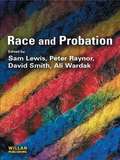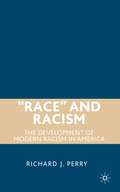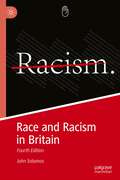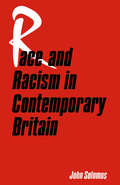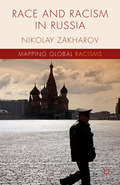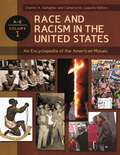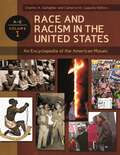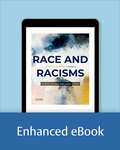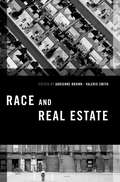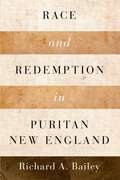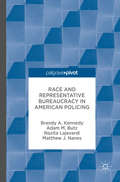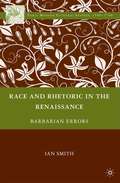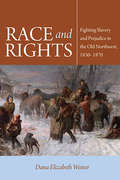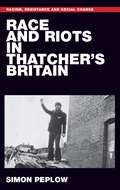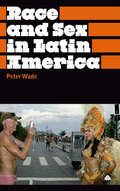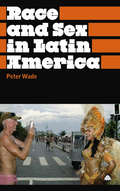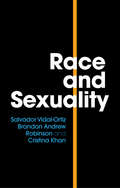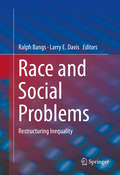- Table View
- List View
Race and Probation
by Sam Lewis Peter Raynor David Smith Ali WardakThe issue of minority ethnic groups' experiences of the criminal justice process, and in particular whether they are subject to disadvantageous treatment, has received much attention in recent years following high-profile events such as the publication of the Macpherson report in 1999 and the riots involving British-born Asian youths in northern towns in 2001. At the same time there has been a burgeoning body of research evidence about the needs and experiences of minority ethnic offenders, the behaviour of racially motivated offenders, and concern with 'What Works' to reduce recidivism by members of both groups. This book reviews this field, drawing upon the largest study of minority ethnic probationers ever conducted in Europe, and seeks to understand the 'stark contrast between the experience of white and black minority ethnicpeople in some areas of the criminal justice system'. Part 1 of the book sets out the context of recent policy, research and practice initiatives; Part 2 focuses on the needs and experiences of minority ethnic offenders; Part 3 discusses aspects of recent practice and policy; Part 4 reviews conclusions and the way forward. Race and Probation also contributes to the wider debate about race and crime. The lessons learned will be of key importance as new arrangements linked to NOMS (National Offender Management Service) come in to place. It will be essential reading forprobation trainees and students of criminal justice, for probation practitioners and managers, and for academics and researchers in the field.
Race and Probation
by David Smith Sam Lewis Peter Raynor Ali WardakThe issue of minority ethnic groups' experiences of the criminal justice process, and in particular whether they are subject to disadvantageous treatment, has received much attention in recent years following high-profile events such as the publication of the Macpherson report in 1999 and the riots involving British-born Asian youths in northern towns in 2001. At the same time there has been a burgeoning body of research evidence about the needs and experiences of minority ethnic offenders, the behaviour of racially motivated offenders, and concern with 'What Works' to reduce recidivism by members of both groups. This book reviews this field, drawing upon the largest study of minority ethnic probationers ever conducted in Europe, and seeks to understand the 'stark contrast between the experience of white and black minority ethnicpeople in some areas of the criminal justice system'. Part 1 of the book sets out the context of recent policy, research and practice initiatives; Part 2 focuses on the needs and experiences of minority ethnic offenders; Part 3 discusses aspects of recent practice and policy; Part 4 reviews conclusions and the way forward. Race and Probation also contributes to the wider debate about race and crime. The lessons learned will be of key importance as new arrangements linked to NOMS (National Offender Management Service) come in to place. It will be essential reading forprobation trainees and students of criminal justice, for probation practitioners and managers, and for academics and researchers in the field.
“Race” and Racism: The Development of Modern Racism in America
by R. Perry'Race' and Racism examines the origins and development of racism in North America. It addresses the inception and persistence of the concept of 'race' and discusses the biology of human variance, addressing the fossil record of human evolution, the relationship between creationism and science, population genetics, 'race'-based medicine, and other related issues. The book explores the diverse ways in which people in a variety of cultures have perceived, categorized, and defined one another without reference to any concept of 'race.' It follows the history of American racism through slavery, the perceptions and treatment of Native Americans, Jim Crow laws, attitudes toward Irish and Southern European immigrants, the internment of Japanese Americans during World War II, the civil rights era, and numerous other topics.
Race and Racism in Britain: Fourth Edition
by John SolomosThis Fourth Edition of a pioneering handbook provides a critical analysis of the origins and evolution of political and policy debates regarding race and racism in British society. Drawing on a broad range of both theoretical and historical research, the focus of the book is on the development of policies and debates in the period from the second half of the 20th Century to the present. The book is organized into twelve chapters which provide an overview of key trends, situating the development of policies and developments in relation to immigration and citizenship, race relations policies and broader agendas about multiculturalism and living with difference. In the substantive chapters of the book there is also a detailed discussion of such issues as policing, urban unrest and protest, racist politics, black and ethnic minority politics and conversations about multiculturalism. This new edition engages with both the historical background as well as contemporary developments to provide a novel and wide-ranging account of the role that questions about race and racism play in British society.
Race and Racism in Britain (PDF)
by John SolomosThe third edition of Race and Racism in Britain provides a detailed and critical analysis of race relations and the differing forms of racism in British society today.
Race and Racism in Contemporary Britain
by John SolomosA critical study of the issues which are fundamental to the understanding of race and racism in modern Britain, this book examines the history of recent issues, the development of central and local government policies, the role of racist organizations, urban unrest and social change.
Race and Racism in Russia (Mapping Global Racisms)
by N. ZakharovRace and Racism in Russia identifies the striking changes in racial ideas, practices, exclusions and violence in Russia since the 1990s, revealing how 'Russianness' has become a synonym for racial whiteness. This ground-breaking book provides new theories and substantive insights into race and ethnicity in a Russian context.
Race and Racism in the United States [4 volumes]: An Encyclopedia of the American Mosaic [4 volumes]
by Charles A. Gallagher Cameron D. LippardHow is race defined and perceived in America today, and how do these definitions and perceptions compare to attitudes 100 years ago… or 200 years ago? This four-volume set is the definitive source for every topic related to race in the United States.In the 21st century, it is easy for some students and readers to believe that racism is a thing of the past; in reality, old wounds have yet to heal, and new forms of racism are taking shape. Racism has played a role in American society since the founding of the nation, in spite of the words "all men are created equal" within the Declaration of Independence. This set is the largest and most complete of its kind, covering every facet of race relations in the United States while providing information in a user-friendly format that allows easy cross-referencing of related topics for efficient research and learning.The work serves as an accessible tool for high school researchers, provides important material for undergraduate students enrolled in a variety of humanities and social sciences courses, and is an outstanding ready reference for race scholars. The entries provide readers with comprehensive content supplemented by historical backgrounds, relevant examples from primary documents, and first-hand accounts. Information is presented to interest and appeal to readers but also to support critical inquiry and understanding. A fourth volume of related primary documents supplies additional reading and resources for research.
Race and Racism in the United States [4 volumes]: An Encyclopedia of the American Mosaic [4 volumes]
How is race defined and perceived in America today, and how do these definitions and perceptions compare to attitudes 100 years ago… or 200 years ago? This four-volume set is the definitive source for every topic related to race in the United States.In the 21st century, it is easy for some students and readers to believe that racism is a thing of the past; in reality, old wounds have yet to heal, and new forms of racism are taking shape. Racism has played a role in American society since the founding of the nation, in spite of the words "all men are created equal" within the Declaration of Independence. This set is the largest and most complete of its kind, covering every facet of race relations in the United States while providing information in a user-friendly format that allows easy cross-referencing of related topics for efficient research and learning.The work serves as an accessible tool for high school researchers, provides important material for undergraduate students enrolled in a variety of humanities and social sciences courses, and is an outstanding ready reference for race scholars. The entries provide readers with comprehensive content supplemented by historical backgrounds, relevant examples from primary documents, and first-hand accounts. Information is presented to interest and appeal to readers but also to support critical inquiry and understanding. A fourth volume of related primary documents supplies additional reading and resources for research.
Race and Racisms: A Critical Approach
by Tanya Maria Golash-BozaRace and Racisms: A Critical Approach, Third Edition, engages students in significant--and timely--questions related to racial dynamics in the U.S. and around the world. Written in accessible, straightforward language, the book discusses and critically analyzes cutting-edge scholarship in the field. Organized into topics and concepts rather than discrete racial groups, the text addresses: * How and when the idea of race was created and developed * How structural racism has worked historically to reproduce inequality * How we have a society rampant with racial inequality though most people do not consider themselves to be racist * How race, class, and gender work together to create inequality and identities * How immigration policy in the United States has been racialized * How racial justice could be imagined and realized Centrally focused on racial dynamics, Race and Racisms, Third Edition, incorporates an intersectional perspective, discussing the intersections of racism, patriarchy, and capitalism.
Race and Racisms: A Critical Approach
by Tanya Maria Golash-BozaRace and Racisms: A Critical Approach, Third Edition, engages students in significant--and timely--questions related to racial dynamics in the U.S. and around the world. Written in accessible, straightforward language, the book discusses and critically analyzes cutting-edge scholarship in the field. Organized into topics and concepts rather than discrete racial groups, the text addresses: * How and when the idea of race was created and developed * How structural racism has worked historically to reproduce inequality * How we have a society rampant with racial inequality though most people do not consider themselves to be racist * How race, class, and gender work together to create inequality and identities * How immigration policy in the United States has been racialized * How racial justice could be imagined and realized Centrally focused on racial dynamics, Race and Racisms, Third Edition, incorporates an intersectional perspective, discussing the intersections of racism, patriarchy, and capitalism.
Race and Real Estate (Transgressing Boundaries: Studies in Black Politics and Black Communities)
Race and Real Estate brings together new work by architects, sociologists, legal scholars, and literary critics that qualifies and complicates traditional narratives of race, property, and citizenship in the United States. Rather than simply rehearsing the standard account of how blacks were historically excluded from homeownership, the authors of these essays explore how the raced history of property affects understandings of home and citizenship. While the narrative of race and real estate in America has usually been relayed in terms of institutional subjugation, dispossession, and forced segregation, the essays collected in this volume acknowledge the validity of these histories while presenting new perspectives on this story.
RACE AND REAL ESTATE C (Transgressing Boundaries: Studies in Black Politics and Black Communities)
by Valerie Smith Adrienne BrownRace and Real Estate brings together new work by architects, sociologists, legal scholars, and literary critics that qualifies and complicates traditional narratives of race, property, and citizenship in the United States. Rather than simply rehearsing the standard account of how blacks were historically excluded from homeownership, the authors of these essays explore how the raced history of property affects understandings of home and citizenship. While the narrative of race and real estate in America has usually been relayed in terms of institutional subjugation, dispossession, and forced segregation, the essays collected in this volume acknowledge the validity of these histories while presenting new perspectives on this story.
Race and Redemption in Puritan New England (Religion in America)
by Richard A. BaileyAs colonists made their way to New England in the early seventeenth century, they hoped their efforts would stand as a "citty upon a hill." Living the godly life preached by John Winthrop would have proved difficult even had these puritans inhabited the colonies alone, but this was not the case: this new landscape included colonists from Europe, indigenous Americans, and enslaved Africans. In Race and Redemption in Puritan New England, Richard A. Bailey investigates the ways that colonial New Englanders used, constructed, and re-constructed their puritanism to make sense of their new realities. As they did so, they created more than a tenuous existence together. They also constructed race out of the spiritual freedom of puritanism.
Race and Redemption in Puritan New England (Religion in America)
by Richard A. BaileyAs colonists made their way to New England in the early seventeenth century, they hoped their efforts would stand as a "citty upon a hill." Living the godly life preached by John Winthrop would have proved difficult even had these puritans inhabited the colonies alone, but this was not the case: this new landscape included colonists from Europe, indigenous Americans, and enslaved Africans. In Race and Redemption in Puritan New England, Richard A. Bailey investigates the ways that colonial New Englanders used, constructed, and re-constructed their puritanism to make sense of their new realities. As they did so, they created more than a tenuous existence together. They also constructed race out of the spiritual freedom of puritanism.
Race and Representative Bureaucracy in American Policing
by Brandy A. Kennedy Adam M. Butz Nazita Lajevardi Matthew J. NanesThis book examines issues of race and policing through the lens of representative bureaucracy theory. According to representative bureaucracy theory, demographic correspondence between government employees and the local population can lead to more favorable outcomes for minority groups. It argues that police forces with higher minority composition will have more positive outcomes across measures such as fewer excessive force complaints and fewer fatal encounters with officers. Additionally, the book asserts that more representative forces will demonstrate responsiveness and accountability by implementing policies such as citizen review boards for excessive force complaints. It does this by first providing a brief overview of issues surrounding race and policing in America, documenting racial representation occurring in local police forces nationwide, and exploring the potential causes and consequences of underrepresentation. It concludes by discussing the implications of our findings and offer potential policy remedies and solutions that local law enforcements can pursue in order to reduce minority underrepresentation and improve policing outcomes.
Race and Representative Bureaucracy in American Policing
by Brandy A. Kennedy Adam M. Butz Nazita Lajevardi Matthew J. NanesThis book examines issues of race and policing through the lens of representative bureaucracy theory. According to representative bureaucracy theory, demographic correspondence between government employees and the local population can lead to more favorable outcomes for minority groups. It argues that police forces with higher minority composition will have more positive outcomes across measures such as fewer excessive force complaints and fewer fatal encounters with officers. Additionally, the book asserts that more representative forces will demonstrate responsiveness and accountability by implementing policies such as citizen review boards for excessive force complaints. It does this by first providing a brief overview of issues surrounding race and policing in America, documenting racial representation occurring in local police forces nationwide, and exploring the potential causes and consequences of underrepresentation. It concludes by discussing the implications of our findings and offer potential policy remedies and solutions that local law enforcements can pursue in order to reduce minority underrepresentation and improve policing outcomes.
Race and Rhetoric in the Renaissance: Barbarian Errors (Early Modern Cultural Studies 1500–1700)
by I. SmithThis book argues that the sixteenth-century preoccupation with rehabilitating English tells the larger story of an anxious nation redirecting attention away from its own marginal, minority status by racially scapegoating the 'barbarous' African.
Race and Rights: Fighting Slavery and Prejudice in the Old Northwest, 1830–1870
by Dana Elizabeth WeinerIn the Old Northwest from 1830 to 1870, a bold set of activists battled slavery and racial prejudice. This book is about their expansive efforts to eradicate southern slavery and its local influence in the contentious milieu of four new states carved out of the Northwest Territory: Illinois, Indiana, Michigan, and Ohio. While the Northwest Ordinance outlawed slavery in the region in 1787, in reality both it and racism continued to exert strong influence in the Old Northwest, as seen in the race-based limitations of civil liberties there. Indeed, these states comprised the central battleground over race and rights in antebellum America, in a time when race's social meaning was deeply infused into all aspects of Americans' lives, and when people struggled to establish political consensus.Antislavery and anti-prejudice activists from a range of institutional bases crossed racial lines as they battled to expand African American rights in this region. Whether they were antislavery lecturers, journalists, or African American leaders of the Black Convention Movement, women or men, they formed associations, wrote publicly to denounce their local racial climate, and gave controversial lectures. In the process, they discovered that they had to fight for their own right to advocate for others. This bracing new history by Dana Elizabeth Weiner is thus not only a history of activism, but also a history of how Old Northwest reformers understood the law and shaped new conceptions of justice and civil liberties. The newest addition to the Mellon-sponsored Early American Places Series, Race and Rights will be a much-welcomed contribution to the study of race and social activism in nineteenth-century America.
Race and riots in Thatcher's Britain (Racism, Resistance and Social Change)
by Simon PeplowThis powerful and original book locates the anti-police violence that spread across England in 1980-1 within a longer struggle against racism and disadvantage faced by black Britons, which had seen a growth in more militant forms of resistance since the Second World War. It explains these disturbances as ‘collective bargaining by riot’ – attempts to increase political inclusion by this marginalised group. Through case studies of Bristol, Brixton and Manchester, the book explores the actions of community organisations in the aftermath of disorders. Highlighting the political activities of black Britons and the often-problematic reliance upon ‘official’ sources when forming historical narratives, it demonstrates the contested value awarded to public inquiries – contrastingly viewed by black Britons as either a method for increased political participation or simply a governmental diversionary tactic.
Race and riots in Thatcher's Britain (Racism, Resistance and Social Change)
by Simon PeplowThis powerful and original book locates the anti-police violence that spread across England in 1980-1 within a longer struggle against racism and disadvantage faced by black Britons, which had seen a growth in more militant forms of resistance since the Second World War. It explains these disturbances as ‘collective bargaining by riot’ – attempts to increase political inclusion by this marginalised group. Through case studies of Bristol, Brixton and Manchester, the book explores the actions of community organisations in the aftermath of disorders. Highlighting the political activities of black Britons and the often-problematic reliance upon ‘official’ sources when forming historical narratives, it demonstrates the contested value awarded to public inquiries – contrastingly viewed by black Britons as either a method for increased political participation or simply a governmental diversionary tactic.
Race and Sex in Latin America (Anthropology, Culture and Society)
by Peter WadeInterracial sexual relations are often a key mythic basis for Latin American national identities, but the importance of this has been under explored. *BR**BR*Peter Wade provides a pioneering overview of the growing literature on race and sex in the region, covering historical aspects and contemporary debates. *BR**BR*He includes both black and indigenous people in the frame, as well as mixed and white people, avoiding the implication that 'race' means 'black-white' relations.
Race and Sex in Latin America (Anthropology, Culture and Society)
by Peter WadeInterracial sexual relations are often a key mythic basis for Latin American national identities, but the importance of this has been under explored. *BR**BR*Peter Wade provides a pioneering overview of the growing literature on race and sex in the region, covering historical aspects and contemporary debates. *BR**BR*He includes both black and indigenous people in the frame, as well as mixed and white people, avoiding the implication that 'race' means 'black-white' relations.
Race and Sexuality
by Salvador Vidal-Ortiz Brandon Andrew Robinson Cristina KhanThe connections between race and sexuality are constant in our lives, yet they are not often linked together in productive, analytical ways.This illuminating book delves into the interrelation of race and sexuality as inseparable elements of our identities and social lives. The authors approach the topic through an interdisciplinary lens, focusing on power, social arrangements and hierarchies, and the production of social difference. Their analysis maps the historical, discursive, and structural manifestations of race and sexuality, noting the everyday effects that the intersections of these categories have on people’s lived experiences. Considering both US-based and transnational cases, this book presents an empirical grounding for understanding how race and sexuality are mutually constitutive categories.Providing a comprehensive overview of racialized sexualities, this book is an essential text for any advanced course on race, sexuality, and intersectionality.
Race and Social Problems: Restructuring Inequality
by Ralph Bangs Larry E. DavisAs much as Americans believe in the promise of an egalitarian, color-blind society, the reality is far from that ideal. People of color consistently lag behind their white counterparts in key quality-of-life areas. Despite many significant gains, widespread structural inequalities continue to exist and thrive. Race and Social Problems takes the long view of this state of affairs, offering both multi-level analysis and a practical blueprint for social justice. It begins by explaining how race-related social problems have changed over the decades. This volume identifies factors contributing to their persistence in this century, most notably the central role of economic disparities in exacerbating related social problems and replicating them for future generations. The chapters expand on this knowledge by detailing innovative and successful strategies for addressing aspects of six major areas of inequality: Poverty: challenging standard American concepts of poverty.Education: approaches toward closing the achievement gap.Intergroup relations: enhancing race dialogues.Family and lifespan: programs targeting families, youth, and elderly.Criminal justice: reducing incarceration and increasing public safety.Health and mental health: promoting positive outcomes. Race and Social Problems casts a wide net across the most pressing social issues, clarifying both the immediate and larger tasks ahead for a range of professionals in such diverse fields as social work, anthropology, communications, criminology, economics, history, law, political science, psychology, public health, and sociology.
